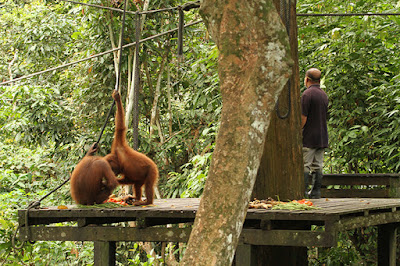In
Borneo, orangutans often are the victims of human-wildlife conflicts. Sepilok Orangutan Rehabilitation Centre,
funded by the Sabah State Government and a number of charity organizations, is
a facility designed to return orphaned, injured, or displaced orangutans back
to the wild. Since its opening in 1964,
hundreds of orangutans rehabilitated there have been released into the
Kapili-Sepilok Forest. According to the
Sabah Wildlife Department’s homepage, orangutans brought to SORC are first
given a health examination and then put in quarantine for a period of time to
prevent the spread of transmittable diseases.
The very young orangutans are kept in the “Nursery” where they are
taught how to find food, climb trees, and build nests (which orangutans do
every night). As the orangutans progress,
they are moved to the larger “Outdoor Nursery” where they are weaned off of
provided food and human support.
Eventually, orangutans who graduate are released into the population of
wild orangutans.
Feeding Platform
The
SORC is open from 9 am to 12 pm, and from 2 pm to 4 pm daily. (9 am to 11 am and 2 pm to 4 pm on
Fridays.) Visitors are encouraged to
arrive at SORC by 9:30 am in order to witness the 10 am feeding, or by 2:30 pm
in order to see the 3:00 pm feeding at the “feeding platform”. When we arrived there at 10:15 on a Sunday,
there was already a crowd of about 200 people.
We were told that most of these visitors were passengers from the same
cruise ship, and that it wasn’t a typical crowd, but judging by the size of the
viewing platform, I believe that large tour groups are not rare at SORC.
At the
time of our visit, there were two orangutans on the feeding platform.
I was
told that the food provided at the feeding platform is only meant to supplement
the diet of the released orangutans, and the daily menu is purposely kept monotonous
in order to encourage the orangutans to become more independent and forage for
more varieties of fruits and vegetation in the larger jungle.
Perhaps
this orangutan was intimidated by the large group of visitors. Maybe she was just anti-social. She kept her back to the tourists as she ate.
Eventually,
most of the visitors moved on to view the even younger orangutans at the “Nursery”.
With
less people watching, the orangutan turned and faced our direction.
After
all of the visitors had moved on, the viewing platform looked like this:
The Nursery
On the day of our visit, the
younger orangutans were on view only until about 11:00 a.m. We didn’t properly understand the directions
from the staff, and by the time we arrived at the Nursery, the young orangutans
had been returned to their indoor quarters and all of the tourists had also
left. Visitors to this building can sit
in air-conditioned comfort while watching the young orangutans as they learn
how to climb and swing on an apparatus quite similar to the “jungle gyms” found
in elementary school yards. I was told
that the windows were actually two-way mirrors, and that while the visitors
could see the young orangutans play outside, the orangutans could not see the
visitors inside the building.
Educational Efforts - Opportunities
for Animal Encounters
SORC had a number of displays
with explanations about the facility and about the orangutans. There were displays next to the indoor ticket
counter.
At
the gate leading into the forest, visitors were told to leave all bags and
backpacks.
Staff
explained that the orangutans and macaques in the forest were free to approach
the human pathways, and on occasion, have been known to steal tourists’
belongings. While there are no organized opportunities for animal encounters,
the wild animals may take it upon themselves to provide one.
Pathway
leading to feeding platform. Visitors
must stay on the designated path.
The
remnants of an orangutan nest. Based on
the dried condition of the leaves, I was told that this particular nest had
been used weeks ago.
More
explanatory signage located at the viewing platform.
Souvenirs and Food
In the SORC entrance building,
there was a small souvenir shop. There
were T-shirts, postcards, keychains, refrigerator magnets, mug cups, and a
variety of other branded and non-branded goods.
Next
to the SORC entrance building there was a small café with seating for about 30
to 40 people.
Interior
of the café. Prices were reasonable, and
the food was tasty. I ordered a chicken
curry and rice dish for 11 Ringgit and a fresh lime juice which was 6 Ringgit.
Getting There
Sepilok
Orangutan Rehabilitation Centre is located about 45 minutes by bus from
Sandakan Town. I visited this facility
while on an organized tour, and our private transportation took us to SORC
straight from Sandakan Airport. I would
recommend consulting with your tour arranger or hotel concierge. Admission differed for Malaysian citizens and
non-citizens. Admission for
Non-Malaysian adults was 30 Ringgit, for non-Malaysian children, 15
Ringgit. Additionally, there is a 10
Ringgit charge for each still camera or video camera you carry.
(Note:
All photos in this post were taken during a visit on February 12, 2017. The comments in this post are based on
observations made on that day. Times and
conditions may have since changed.
Please check it out for yourself!)






















